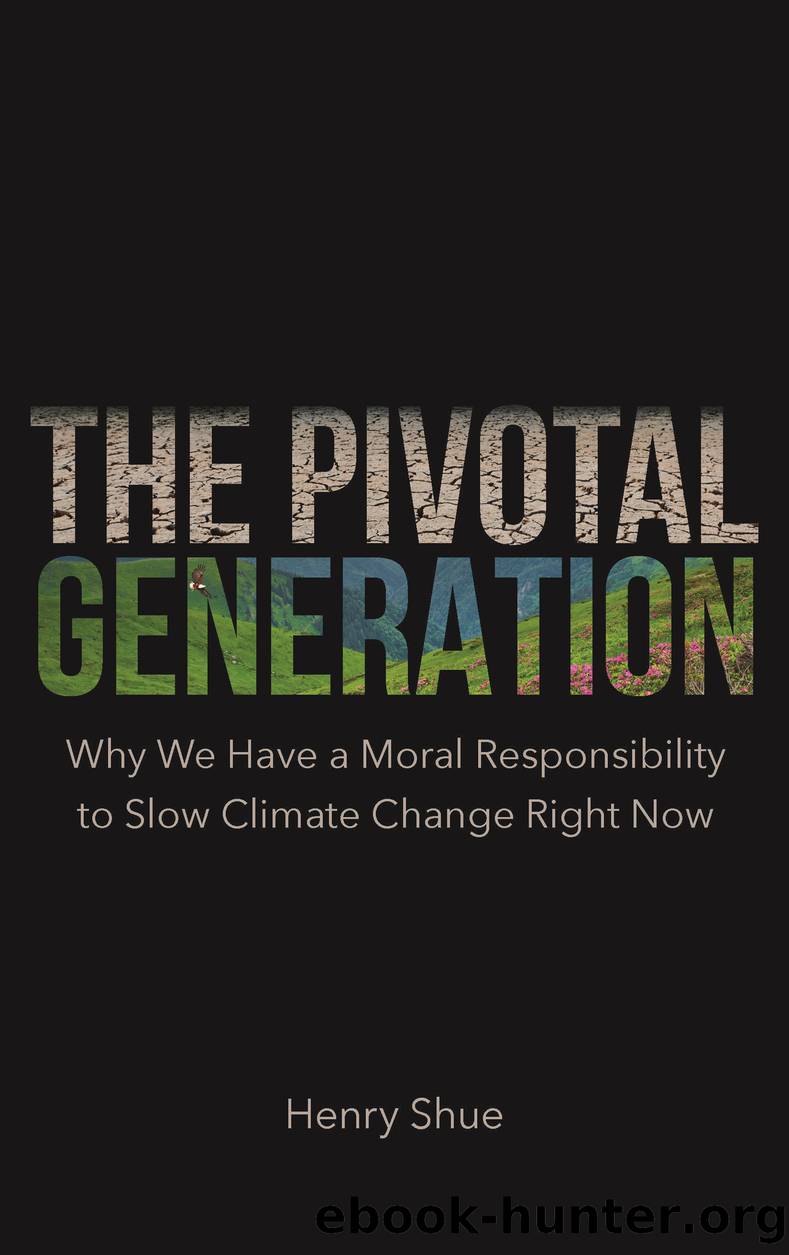The Pivotal Generation by Henry Shue;

Author:Henry Shue;
Language: eng
Format: epub
Publisher: Princeton University Press
Published: 2021-09-23T00:00:00+00:00
Bequeathing Risks
We now turn to a normative analysis of the relation between the level of the present-day ambition to stop contributing to climate change and the risk of danger for future generationsâbetween present inaction and future danger. We explore the structure of the risks created by every decision about how ambitiously to mitigate the primary factor forcing climate change, CO2, and thereby reveal the deepest objection to the current half-hearted and half-baked mitigation. The two main theses in this section of the chapter are (1) that, in general, all decisions in the present about the degree of ambition for emissions mitigation are unavoidably also decisions about how to distribute risk across generations; and (2) that, more specifically, the less ambitious the mitigation is, the more inherently objectionable the resulting intergenerational risk distribution is.41 One of the most tempting ways by which a countryâs policy-makers can persuade themselves that less than a reasonable amount of mitigation now is permissible is by assuming that remedial CDR later would be just as good as more mitigation nowâby gambling that remedial CDR will be fully equivalent to ambitious mitigation (including any enhancement CDR) now. This is not a reasonable gamble, as I will now try to show. The following normative structural analysis of risk thus has strong implications for the standards of assessment by which to judge national implementation of the 2015 Paris Agreement, especially the extent of the ratcheting up of each nationâs NDCs as mandated by the Agreement.
Every risk, as Hermansson and Hansson note, involves âthree roles, namely the risk exposed, the decision-maker and the beneficiary.â42 The three roles may be occupied respectively by one, two, or three parties. How the three roles are allocated among the parties involved gives the risk what I am calling its âstructure.â In the simplest case, all three roles are occupied by the same person who chooses to gamble and receives the benefits or suffers the losses of the gamble. If, instead, for example, the decision-maker is one party and a single other person is both the intended beneficiary and the risk-exposed, the structure of the choice may be paternalistic.43 For instance, the legislature requires motorcycle helmets, and cyclists benefit from greater safety and suffer the loss of the thrill of greater danger.
Or, to see a different structure, take the typical choice by a firm to externalize the environmental costs of its operations. The firm is the decision-maker about how much to pollute, and it is itself the beneficiary of the reduced costs relative to controlling the pollution, while third parties bear the costs and suffer the harms created by the pollution. Other people are stuck with the costs of dealing with the pollution in order to reduce production costs for the firm. This structure constitutes corporate exploitation of the public. We saw in chapter 2 that externalization at the national levelâsovereign externalizationâuses the remainder of the planet for waste disposal.
John Rawls focused attention on a simple situation for choice between two alternatives, which I have modified in the following in important respects, partly following Stephen Gardiner.
Download
This site does not store any files on its server. We only index and link to content provided by other sites. Please contact the content providers to delete copyright contents if any and email us, we'll remove relevant links or contents immediately.
Man-made Catastrophes and Risk Information Concealment by Dmitry Chernov & Didier Sornette(5924)
The Revenge of Geography: What the Map Tells Us About Coming Conflicts and the Battle Against Fate by Kaplan Robert D(4036)
Zero Waste Home by Bea Johnson(3781)
COSMOS by Carl Sagan(3559)
Good by S. Walden(3489)
In a Sunburned Country by Bill Bryson(3486)
The Fate of Rome: Climate, Disease, and the End of an Empire (The Princeton History of the Ancient World) by Kyle Harper(3007)
A Wilder Time by William E. Glassley(2818)
Camino Island by John Grisham(2763)
The Ogre by Doug Scott(2634)
Organic Mushroom Farming and Mycoremediation by Tradd Cotter(2631)
Human Dynamics Research in Smart and Connected Communities by Shih-Lung Shaw & Daniel Sui(2466)
Energy Myths and Realities by Vaclav Smil(2439)
The Traveler's Gift by Andy Andrews(2410)
9781803241661-PYTHON FOR ARCGIS PRO by Unknown(2325)
Inside the Middle East by Avi Melamed(2305)
Birds of New Guinea by Pratt Thane K.; Beehler Bruce M.; Anderton John C(2226)
A History of Warfare by John Keegan(2186)
And the Band Played On by Randy Shilts(2131)
